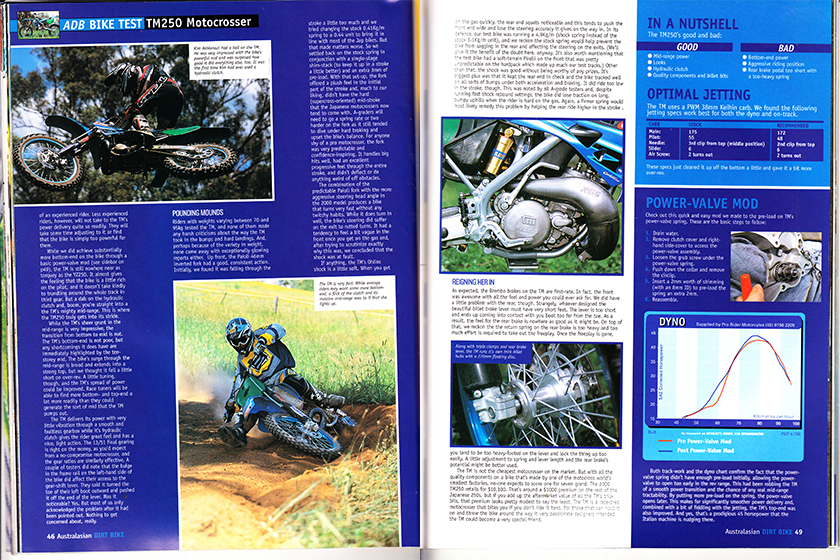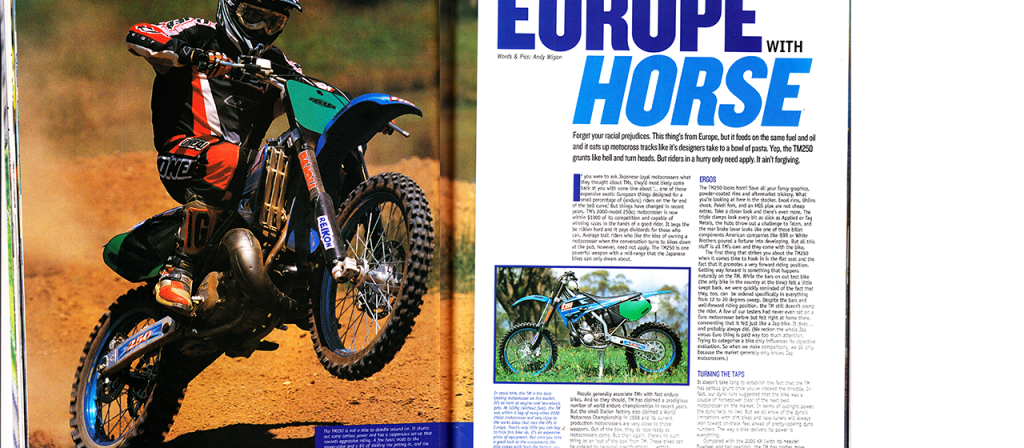With a number of World Enduro Championships and the 1998 World MX Championship to its name, the Italian brand certainly had the pedigree and it used top-shelf components.
For the extra bucks, you got Excel rims, an Ohlins shock, Paoli fork, HGS pipe, triple-clamps and hubs that threw out a challenge to Tag Metals and Talon, Brembo brakes and a hydraulic clutch.
This particular TM 250 was the only one in the country at the time ADB had it on test and a little fiddling was tried to smooth out the jetting and the power delivery. The grunt in the mid-range impressed our testers but not the transition from bottom-end to mid-.
The bottom was not poor, but its shortcomings were highlighted by a broad mid-range that extended into a strong top-end, although it was felt to be a little short on over-rev. A bit of adjustment with the jets in the PWM 38mm Keihin carb cleaned things up off the bottom and supplied a bit more over-rev.
Adding 2mm of shims to the power valve spring made the valve open later, giving a significantly smoother power delivery and better transition into the mid-range. The results of this fine tuning saw a dyno reading of 45hp.
It was the mid-range that really drew the attention of ADB’s tester Kim Ashkenazi, leaving him very impressed but it was thought that perhaps less experienced riders would take some time to adjust, or simply find it too powerful. The 46mm USD leading-axle fork was found to fall through the stroke a little too quickly compared to Japanese bikes with the stock 0.41kg/m springs, so a set of 0.44s was tried.
This was worse and the issue was eventually solved with the standard springs, a single-stage shim stack and 3mm of pre-load. The TM turned in well but could be a bit vague in the front once on the throttle hard, to exit a corner. It was decided that the culprit was the rear spring which was a 4.9kg/m one instead of the 5.1kg/m fitted as standard. The softer spring was allowing too much squat under hard acceleration, allowing the front-end to run wide.
The front brake was claimed to be “awesome with all the power and feel you could ask for” but the rear brake presented problems with feel and it locked up. The brake pedal was considered to be too short, making contact with a rider’s boot too far back, and the return spring was too heavy, which combined to make delicate brake application difficult.
A unique thing about the TMs was that they could be ordered with a certain amount of personalisation, within limits, for a rider’s weight and ability, with the suspension being set up for each buyer at the factory. This even extended to handlebar choice, with options from 12 to 20 degrees of sweep.
To sum up, our test had this to say about the bike: “The TM is a race-bred motocrosser that bites you if you don’t ride it hard. For those who can hold it on and throw the bike around the way it’s very-passionate designers intended, the TM could become a very special friend.” Heritage Editor Warren Jack

